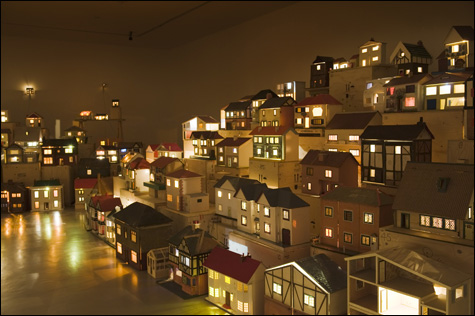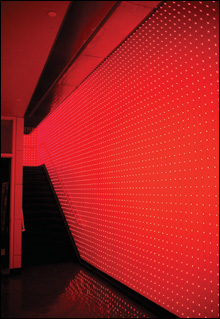
ABSENCE/PRESENCE: When she started on Place (Village), Whiteread was thinking of Pompeii and
Italian Nativity scenes. |
Photos: Rachel Whiteread exhibit at the MFA
Rachel Whiteread | Museum of Fine Arts, 465 Huntington Ave | Through January 25
Erwin Redl, “Fade: A Light Installation” | Huret and Spector Gallery, Emerson College, 10 Boylston Place | Through November 30 |
The gallery is dark for Rachel Whiteread’s Place (Village) installation at the Museum of Fine Arts, except for lights glowing within the neighborhoods of little houses stacked up around the edges of the room, as if on three hillsides. They turn out to be more than 200 second-hand dollhouses that the 45-year-old London sculptor has stacked on the wooden shipping crates they were sent to the museum in. It feels like bedtime in the village of girlhood dreams.The installation is a bit of a shift for Whiteread, who’s best known for making plaster, rubber, resin, or concrete casts of old used mattresses, sinks, the hollows underneath chairs, a two-story staircase, the entire interior of rooms. She won the big-deal British art award the Turner Prize in 1993 just after she created House, a concrete cast of the stripped-bare interior of a condemned Victorian house in London.

MFA contemporary curator Cheryl Brutvan (who is expected to leave the museum by the end of the year, with unspecified plans) has put together a sharp, small, focused show. She gives context to the installation with a sampler of six Whiteread sculptures and 16 drawings and collages. Untitled (Amber Floor) (1993) is a fleshy yellow rubber cast of worn floorboards. Wait (2005) features plaster casts of cardboard boxes — with all their dents and dings — stacked on and under a chair. Cabinet XI (2007) is a metal medicine chest filled with plaster casts of the insides of pillboxes. In-Out-VI (2004) is the result of casting a door and then turning it inside out so that it becomes a new door. Whiteread’s style comes out of classic Minimalism — simple, spare boxes, emphasis on materials and their placement in the gallery — but she warms it with the objects’ sense of past use by people now gone in places now lost. Her sculptures often feel like gravestones or mausoleums or ghosts.
“I started collecting dollhouses over 20 years ago,” she tells me. “I had no idea whatsoever where they were going. I just started picking them up in flea markets and stuff. It was completely connected to everything that I’ve always done. It had to do with the interiors of them, and opening the doors and seeing these strangely decorated landscapes that were people’s ideas of what the perfect house would be. And their kind of strangeness of oversize wallpaper — the scale of the wallpapers was directly related to the suburban house they lived in, and they just kind of put the scraps in the doll’s house, and bits of carpet and stuff. So they were little versions of mini-me, the people that had made these. And then they’d been passed down through generations and then eventually just spat out somewhere for me to collect.”

FADE: Redl uses bad feng shui to his
advantage. |
The dollhouses filled up shelves in her East London studio. At the MFA, collaged drawings dating back to 2004 explain how she began thinking of making something with them. She cut out magazine photos of houses and pasted them into rings and stacks. When Whiteread was invited to show in Naples last year, she created her first version of Place (Village) with some 60 dollhouses. She was thinking of Pompeii and the Italian Nativity scenes called presepi. The arrangement also grew out of her 2005 installation Embankment, which filled a giant hall at London’s Tate Modern with mountains built from 14,000 stacked polyethylene casts of packing boxes.Whiteread’s work usually focuses on domestic interiors. Here, we peek in through the dollhouse doors and windows and glimpse little rooms with odd wallpaper, little fireplaces, and stairs, but the homes are closed to us. It’s like walking down streets at night and peering through windows into lit rooms.
Like much of Whiteread’s work, Place (Village) feels melancholy. It reminds me of the title of Mike Kelley’s 1987 crazy quilt of second-hand dolls and afghans: More Love Hours Than Can Ever Be Repaid. It’s a village of hopes and dream(house)s, where fantasies of love and life and family were played out by dozens of little girls. Now it’s a silent, abandoned place. And you wonder how real life played out for these invisible girls as they put away their childhood things.
Emerson College’s Huret and Spector Gallery has its own light installation with Austrian artist Erwin Redl’s Fade. The gallery is an awkward chopped-up narrow space divided into two floors that often doesn’t flatter art. But Redl uses this lousy feng shui to his advantage by filling the walls with a grid of thousands of red LED lights that dramatize the gallery’s odd shapes. It feels like walking into some scene from Tron.